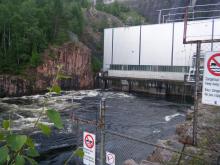The Mission
 Approximately 475 hydropower facilities distributed across Canada generate 60% of the electricity used by Canadians. Storage of hydropower in a reservoir provides operational flexibility, responding to increased demand by releasing more water through its turbines. Rising demand for energy and interest in renewable energy will require additional facilities and increased production from existing installations. They range from run-of-the river to large reservoirs to pumped storage. These hydroelectric facilities have a direct influence on all physical, chemical and biological processes that take place in aquatic ecosystems, and eventually, on their capacity to produce biomass, such as fish.
Approximately 475 hydropower facilities distributed across Canada generate 60% of the electricity used by Canadians. Storage of hydropower in a reservoir provides operational flexibility, responding to increased demand by releasing more water through its turbines. Rising demand for energy and interest in renewable energy will require additional facilities and increased production from existing installations. They range from run-of-the river to large reservoirs to pumped storage. These hydroelectric facilities have a direct influence on all physical, chemical and biological processes that take place in aquatic ecosystems, and eventually, on their capacity to produce biomass, such as fish.
The overarching mission NSERC HydroNet is to conduct research designed to provide industry and government with the knowledge and tools that will permit the sustainable development of hydropower in Canada. Fulfillment of this mission requires that research conducted within NSERC HydroNet is directly coupled to the regulatory framework that defines the decision making process. One guiding principle of a particularly determinant component of the regulatory framework, the Policy for the Management of Fish Habitat from Fisheries and Oceans Canada, requires that there is “no net loss” of the productive capacity of fish habitats (i.e. maximum fish biomass naturally produced per unit of time). According to this principle, the assessment of the effect of hydropower on an aquatic ecosystem entails the estimation of the productive capacity of fish habitat within an ecosystem prior to development, the prediction of the productive capacity during the post-development phase, and the continued monitoring post-development to corroborate the validity of those predictions. However, there is neither consensus on the methods or the metrics that should be used to estimate productive capacity of fish habitats on a routine basis, nor on the variables that best predict the effects of hydropower on productive capacity. The development of new knowledge and tools to support the implementation of the principle of “no net loss” of the productive capacity of fish habitats constitutes the central axis of the research mission of NSERC HydroNet.
NSERC HydroNet intends to achieve its mission by promoting the exchange of ideas, expertise, data, and solutions among scientists and managers from all regions of Canada. The presence in the Network of specialists in thermodynamics, hydrodynamics, geomorphology, physiology, ecology, and numerical analysis creates a mutually enriching inter-disciplinary environment that favours the training of the students that will form a generation of government, industry and university scientists, engineers, and managers that is better prepared to deal with complex issues. Science-based practical solutions developed by the combined expertise of the members of NSERC HydroNet is expected to provide industry and government managers with new knowledge and tools to assess, mitigate, and minimize the potential effects on the productive capacity of fish habitats, to improve the decision-making process associated with hydropower operations, to reduce conflict among stakeholders, and hence, to promote the sustainable hydropower in Canada.
